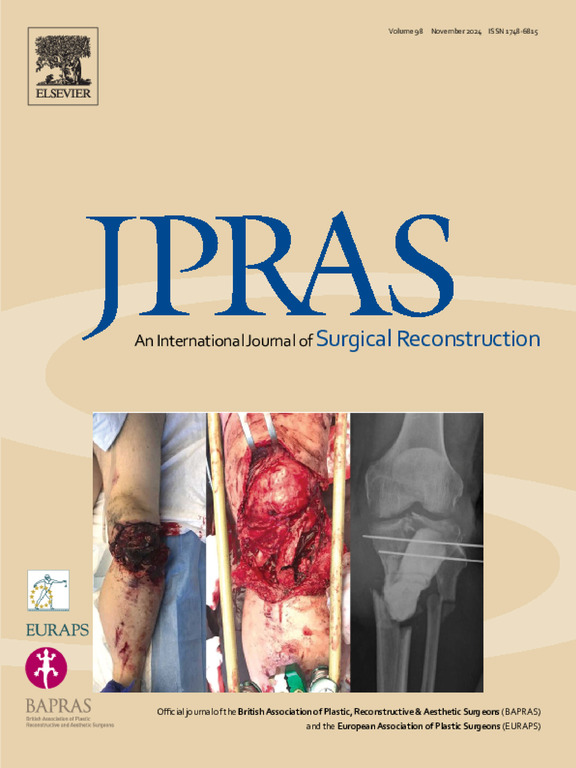神经假体在单侧面神经麻痹修复中的应用:范围综述
IF 2
3区 医学
Q2 SURGERY
Journal of Plastic Reconstructive and Aesthetic Surgery
Pub Date : 2024-11-15
DOI:10.1016/j.bjps.2024.11.006
引用次数: 0
摘要
面神经麻痹会给患者带来功能、心理和外观方面的问题。虽然各种外科技术可以改善保守治疗后仍未完全康复的患者的面部功能和外观,但这些技术可能具有广泛的创伤性,对面部运动和对称性的恢复有限。功能性电刺激(FES)是一种用于刺激瘫痪神经或肌肉的技术,在面神经麻痹治疗中有两种不同的应用:面部康复和神经假体。我们的研究特别关注 FES 的神经假体应用,它使用面部健康一侧的信号来刺激瘫痪一侧。这种新兴的神经假体技术创伤较小,有望同步面部运动。我们进行范围综述的目的是了解已开发模型的情况,以及这些研究在引导瘫痪侧面部运动方面取得的成果。我们在综述中发现了 22 项研究,每项研究都使用了不同的方法来检测健康侧的面部运动,并使用了不同的刺激类型和参数,每项研究都描述了使用健康半面输入成功刺激瘫痪侧面部运动的情况。本文章由计算机程序翻译,如有差异,请以英文原文为准。
The application of neuroprosthesis in restoration of unilateral facial nerve paralysis: A scoping review
Facial nerve palsy can pose functional, psychosocial, and cosmetic issues for patients. Although various surgical techniques can improve facial functions and appearance for patients who do not fully recover following conservative management, they can be extensively invasive with limited restoration of facial movement and symmetry. Functional electrical stimulation (FES) is a technology that has been developed to stimulate paralyzed nerves or muscles and has 2 different applications in facial nerve palsy treatment: facial rehabilitation and neuroprosthesis. Our study focuses specifically on the neuroprosthesis application of FES, which uses signals from the healthy side of the face to stimulate the paralyzed side. This emerging neuroprosthetic technology is less invasive and holds promise in synchronizing facial movements. The purpose of our scoping review was to understand the landscape of the models that have been developed, as well as the outcomes of these studies in leading to facial movement on the paralyzed side. We found 22 studies in our review that each used varying methods for detecting facial movement from the healthy side and differing stimulation types and parameters, with each study describing successful stimulation of facial movement on the paralyzed side using healthy hemiface input.
求助全文
通过发布文献求助,成功后即可免费获取论文全文。
去求助
来源期刊
CiteScore
3.10
自引率
11.10%
发文量
578
审稿时长
3.5 months
期刊介绍:
JPRAS An International Journal of Surgical Reconstruction is one of the world''s leading international journals, covering all the reconstructive and aesthetic aspects of plastic surgery.
The journal presents the latest surgical procedures with audit and outcome studies of new and established techniques in plastic surgery including: cleft lip and palate and other heads and neck surgery, hand surgery, lower limb trauma, burns, skin cancer, breast surgery and aesthetic surgery.

 求助内容:
求助内容: 应助结果提醒方式:
应助结果提醒方式:


